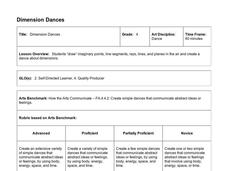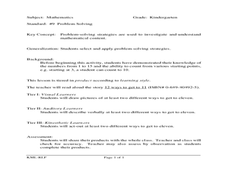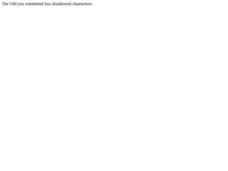Curated OER
Hot Chocolate Problems
Kids love real word math becuase it connects to their everyday life and is really useful to learn. They are given the recipe for hot chocolate, using that recipe they must alter the quantities of each ingredient in order to accommodate a...
Curated OER
Measuring our Hands!
How do we compare? Get your scholars measuring using this interactive and kinesthetic math activity. First, learners compare something (you announce- could be index finger, palm, feet, etc.) to classmates. Consider having them record...
Curated OER
Who Said Math Can't Be Fun?
With these innovative ideas, demonstrate to your class that math doesn't always have to be hard work.
Curated OER
Math, Fractions, and Music
Students discover the relationship between musical rhythms and fractions. They add musical notes together to produce fractions and create addition and subtraction problems with musical notes. Students complete worksheets and create their...
Curated OER
The Ants Go Marching
Integrate art, math, life science, music, and fun in this beginning addition and subtraction activity. Children kinesthetically represent adding and subtracting numbers to 10; they stand up one at a time as you count forward and sit down...
Houghton Mifflin Harcourt
Use Money
Give this to your second and third grade class to practice counting coins. There are six word problems given. Consider giving each learner a few dollars in coins to help kinesthetic learners. Also consider reviewing the word fewer before...
Curated OER
Count by 5's Teaching Idea
Creating while learning is great for visual, spacial, and kinesthetic learners. First graders can use the provided quilt squares to construct their very own count by 5 quilt. Each quilt square shows a picture of a hand with a 5s number...
Hawaiʻi State Department of Education
Dimension Dances
Use dance to help learners conceptualize line segments, rays, lines, and planes. They choreograph dances that show dimensional space. Dancers start by pondering space, point, and lines as the teacher draws them in the air. Each movement...
Curated OER
Learning Styles in Math
Students discover which learning style works best for them in a math setting. In this math comprehension lesson, students create different combinations of numbers that equal the sum of 11. Students determine if they are better visual,...
Curated OER
Integrating Math and Science
Student understanding of math concepts improves when math is integrated with science!
ISTE
Let's Count to 10
Learners form groups of zero to 10 objects. They connect number names to groups, compose and decompose numbers, and use numerals to record the size of a group. The comprehensive, eight-component mini unit addresses the needs of visual,...
Curated OER
Tens and Ones Fun
Youngsters use their large motor skills to build numbers to 20 in this outdoor, kinesthetic, collaborative activity. Amass cardboard boxes for groups to stack, sort, and bundle into 10s and 1s to show numbers and place value. They'll...
Curated OER
Metric Magic
Sixth and seventh graders construct a "metric machine" as a kinesthetic aide in converting from one unit to another in grams, liters, or meters. They complete a metric activity on the Internet and view about five minutes of a video on...
Curated OER
Money
Which coins do you need? Scholars are faced with a challenge: using only three coins they must find the exact amount needed for six items. The coins are standard US currency and are pictured at the top, however their value is not listed....
Hawaiʻi State Department of Education
Symmetrical Objects
In order to better understand how to locate a plane of symmetry in 3-dimensional objects, learners create a dance. The class reviews dance and math symmetry, then they practice making symmetrical shapes and movements with a partner. They...
Curated OER
Multiplication
Students practice their multiplication facts by reinforcement and repetition. Students write facts in their math journals, and use labeled soccer ball and deck of cards to practice multiplying by "number of the day." Play continues until...
Curated OER
Shelf Stacker 1-5
What a fun way to practice counting for youngsters! Especially effective for kinesthetic and visual learners, this activity has scholars stacking "books" on a "bookshelf." Templates are provided for the bookshelves and books; consider...
Curated OER
Addition Grid
Which of these numbers add up to 20? Scholars find various addend pairs in a grid, circling those that add up to 20. There are many pairs they can find here, and the answer sheet offers some excellent kinesthetic practice ideas for...
Curated OER
And 1 More Makes...
If we add one more, how many will we have? Beginners to addition practice this skill using images and counting as they draw one more sock to each set and record the new total. There are three of these followed by four more similar...
Curated OER
And 5 More Makes...
By drawing five more objects to existing sets, scholars begin to understand the concept of addition. They count pails and draw five more, totaling them and recording the sums. There are three of these followed by four more similar...
Curated OER
Fractions of Shapes
Explore fractions visually through segmented shapes. Scholars examine sets of shapes and shade in the given fraction. Each shape is divided into the same number of segments as the denominator of the desired fraction, so beginners aren't...
DK Publishing
Multiplying and Dividing by 10
Your scholars will be glad to know there are helpful tricks when multiplying and dividing by 10; show them this concept through visual examples as they complete these word problems. Using sets of peas they fill in four multiplication...
Curated OER
Probability
What's the probability your scholars will enjoy this instructional activity? Pretty high, especially for visual learners. They examine a table of types of beads in a grab bag. Pupils determine which type is most likely to be picked and...
Curated OER
Inequalities and The Order of Operations
Middle and high schoolers investigate how to solve inequalities. The lesson has a good guide for taking pupils through a direct instruction of the concept. You can use counting tiles in order to help kinesthetic learners.
Other popular searches
- Kinesthetic Math Games
- Kinesthetic Math Activities
- Kinesthetic Math Fractions
- Kinesthetic Math Subtraction
- Kinesthetic Math Lessons
- Kinesthetic Math Plans
- Kinesthetic Math Quadratic
- Kinesthetic Learner Math Time
- Kinesthetic Math Money

























